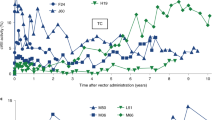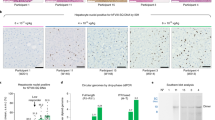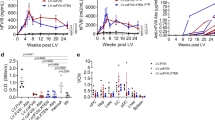Abstract
Adeno-associated viral vector-mediated gene transfer of coagulation factor IX to the skeletal muscle or to liver has resulted in sustained correction of hemophilia B in mice and dogs. The two initial phase I/II AAV clinical trials for hemophilia B, delivering a factor IX cDNA to skeletal muscle or liver, showed no serious adverse events. Although the muscle trial failed to achieve a therapeutic level of factor IX in the circulation, long-term expression of clotting factor was demonstrated on muscle biopsies taken up to 3 years after vector injection. Administration of vector to liver via the hepatic artery identified a therapeutic dose, which agreed closely with the doses predicted by studies in hemophilic dogs. However, expression in human subjects lasted for only a period of weeks, followed by a gradual decline in factor IX levels accompanied by a self-limited, asymptomatic rise and fall in liver enzymes. Immune responses to vector capsid may account for this difference in outcome between humans and other species. Here we review the results from both preclinical and clinical studies of adeno-associated viral vector gene transfer for hemophilia B, and the problems that have been identified and that must be overcome to achieve successful transduction and sustained expression.
This is a preview of subscription content, access via your institution
Access options
Subscribe to this journal
Receive 12 print issues and online access
$259.00 per year
only $21.58 per issue
Buy this article
- Purchase on Springer Link
- Instant access to full article PDF
Prices may be subject to local taxes which are calculated during checkout

Similar content being viewed by others
References
Deichmann A, Hacein-Bey-Abina S, Schmidt M, Garrigue A, Brugman MH, Hu J et al. Vector integration is nonrandom and clustered and influences the fate of lymphopoiesis in SCID-X1 gene therapy. J Clin Invest 2007; 117: 2225–2232.
Aiuti A, Cassani B, Andolfi G, Mirolo M, Biasco L, Recchia A et al. Multilineage hematopoietic reconstitution without clonal selection in ADA-SCID patients treated with stem cell gene therapy. J Clin Invest 2007; 117: 2233–2240.
Schwarzwaelder K, Howe SJ, Schmidt M, Brugman MH, Deichmann A, Glimm H et al. Gammaretrovirus-mediated correction of SCID-X1 is associated with skewed vector integration site distribution in vivo. J Clin Invest 2007; 117: 2241–2249.
Lofqvist T, Nilsson IM, Berntorp E, Pettersson H . Haemophilia prophylaxis in young patients—a long-term follow-up. J Intern Med 1997; 241: 395–400.
Bray GL, Luban NL . Hemophilia presenting with intracranial hemorrhage. An approach to the infant with intracranial bleeding and coagulopathy. Am J Dis Child 1987; 141: 1215–1217.
Manco-Johnson MJ, Abshire TC, Shapiro AD, Riske B, Hacker MR, Kilcoyne R et al. Prophylaxis versus episodic treatment to prevent joint disease in boys with severe hemophilia. N Engl J Med 2007; 357: 535–544.
Palmer TD, Thompson AR, Miller AD . Production of human factor IX in animals by genetically modified skin fibroblasts: potential therapy for hemophilia B. Blood 1989; 73: 438–445.
Yao SN, Kurachi K . Expression of human factor IX in mice after injection of genetically modified myoblasts. Proc Natl Acad Sci USA 1992; 89: 3357–3361.
Yao SN, Wilson JM, Nabel EG, Kurachi S, Hachiya HL, Kurachi K . Expression of human factor IX in rat capillary endothelial cells: toward somatic gene therapy for hemophilia B. Proc Natl Acad Sci USA 1991; 88: 8101–8105.
Kay MA, Manno CS, Ragni MV, Larson PJ, Couto LB, McClelland A et al. Evidence for gene transfer and expression of factor IX in haemophilia B patients treated with an AAV vector. Nat Genet 2000; 24: 257–261.
Herzog R, Yang E, Couto L, Hagstrom J, Elwell D, Fields P et al. Long-term correction of canine hemophilia B by gene transfer of blood coagulation factor IX mediated by adeno-associated viral vector. Nat Med 1999; 5: 56–63.
Manno CS, Pierce GF, Arruda VR, Glader B, Ragni M, Rasko JJ et al. Successful transduction of liver in hemophilia by AAV-Factor IX and limitations imposed by the host immune response. Nat Med 2006; 12: 342–347.
Manno CS, Chew AJ, Hutchison S, Larson PJ, Herzog RW, Arruda VR et al. AAV-mediated factor IX gene transfer to skeletal muscle in patients with severe hemophilia B. Blood 2003; 101: 2963–2972.
Herzog RW, Fields PA, Arruda VR, Brubaker JO, Armstrong E, McClintock D et al. Influence of vector dose on factor IX-specific T and B cell responses in muscle-directed gene therapy. Hum Gene Ther 2002; 13: 1281–1291.
Arruda V, Stedman HH, Jiang H, Pierce GF, Schuettrumpf J, Furlan Freguia C et al. Correction of hemophilia B phenotype by novel method of regional intravenous delivery of AAV vector to skeletal muscle of hemophilia B dogs. Mol Ther 2005; 11 (Suppl): S233.
Herzog RW, Mount JD, Arruda VR, High KA, Lothrop Jr CD . Muscle-directed gene transfer and transient immune suppression result in sustained partial correction of canine hemophilia B caused by a null mutation. Mol Ther 2001; 4: 192–200.
Fields PA, Arruda VR, Armstrong E, Chu K, Mingozzi F, Hagstrom JN et al. Risk and prevention of anti-factor IX formation in AAV-mediated gene transfer in the context of a large deletion of F9. Mol Ther 2001; 4: 201–210.
Su LT, Gopal K, Wang Z, Yin X, Nelson A, Kozyak BW et al. Uniform scale-independent gene transfer to striated muscle after transvenular extravasation of vector. Circulation 2005; 112: 1780–1788.
Snyder RO, Miao CH, Patijn GA, Spratt SK, Danos O, Nagy D et al. Persistent and therapeutic concentrations of human factor IX in mice after hepatic gene transfer of recombinant AAV vectors. Nat Genet 1997; 16: 270–276.
Mount JD, Herzog RW, Tillson DM, Goodman SA, Robinson N, McCleland ML et al. Sustained phenotype correction of hemophilia B dogs with a factor IX null mutation by liver-directed gene therapy. Blood 2002; 99: 2670–2676.
Mingozzi F, Liu YL, Dobrzynski E, Kaufhold A, Liu JH, Wang Y et al. Induction of immune tolerance to coagulation factor IX antigen by in vivo hepatic gene transfer. J Clin Invest 2003; 111: 1347–1356.
Mingozzi F, Maus MV, Hui DJ, Sabatino DE, Murphy SL, Rasko JE et al. CD8(+) T-cell responses to adeno-associated virus capsid in humans. Nat Med 2007; 13: 419–422.
Li H, Murphy SL, Giles-Davis W, Edmonson S, Xiang Z, Li Y et al. Pre-existing AAV capsid-specific CD8+ T cells are unable to eliminate AAV-transduced hepatocytes. Mol Ther 2007; 15: 792–800.
Li C, Hirsch M, Asokan A, Zeithaml B, Ma H, Kafri T et al. Adeno-associated virus type 2 (AAV2) capsid-specific cytotoxic T lymphocytes eliminate only vector-transduced cells coexpressing the AAV2 capsid in vivo. J Virol 2007; 81: 7540–7547.
Wang L, Figueredo J, Calcedo R, Lin J, Wilson JM . Cross-presentation of adeno-associated virus serotype 2 capsids activates cytotoxic T cells but does not render hepatocytes effective cytolytic targets. Hum Gene Ther 2007; 18: 185–194.
Recombinant DNA Advisory Board NIoH. Recombinant AAV Generation and Purification: Strategies to Reduce Vector Immunogenicity. NIH: Bethesda, MD, 2007, http://www4.od.nih.gov/oba/RAC/meeting.html.
Nathwani AC, Gray JT, McIntosh J, Ng CY, Zhou J, Spence Y et al. Safe and efficient transduction of the liver after peripheral vein infusion of self-complementary AAV vector results in stable therapeutic expression of human FIX in nonhuman primates. Blood 2007; 109: 1414–1421.
Nathwani AC, Gray JT, Ng CY, Zhou J, Spence Y, Waddington SN et al. Self-complementary adeno-associated virus vectors containing a novel liver-specific human factor IX expression cassette enable highly efficient transduction of murine and nonhuman primate liver. Blood 2006; 107: 2653–2661.
Mingozzi F, Hasbrouck NC, Basner-Tschakarjan E, Edmonson SA, Hui DJ, Sabatino DE et al. Modulation of tolerance to the transgene product in a nonhuman primate model of AAV-mediated gene transfer to liver. Blood 2007; 110: 2334–2341.
Jiang H, Pierce GF, Ozelo MC, de Paula EV, Vargas JA, Smith P et al. Evidence of multiyear factor IX expression by AAV-mediated gene transfer to skeletal muscle in an individual with severe hemophilia B. Mol Ther 2006; 14: 452–455.
Vandenberghe LH, Wang L, Somanathan S, Zhi Y, Figueredo J, Calcedo R et al. Heparin binding directs activation of T cells against adeno-associated virus serotype 2 capsid. Nat Med 2006; 12: 967–971.
Recombinant DNA Advisory Board NIoH. Use of Immunosuppression with AAV Vectors. NIH: Bethesda, MD, 2007, http://www4.od.nih.gov/oba/RAC/meeting.html.
Nakai H, Yant SR, Storm TA, Fuess S, Meuse L, Kay MA . Extrachromosomal recombinant adeno-associated virus vector genomes are primarily responsible for stable liver transduction in vivo. J Virol 2001; 75: 6969–6976.
Donsante A, Vogler C, Muzyczka N, Crawford JM, Barker J, Flotte T et al. Observed incidence of tumorigenesis in long-term rodent studies of rAAV vectors. Gene Therapy 2001; 8: 1343–1346.
Donsante A, Miller DG, Li Y, Vogler C, Brunt EM, Russell DW et al. AAV vector integration sites in mouse hepatocellular carcinoma. Science 2007; 317: 477.
Author information
Authors and Affiliations
Corresponding author
Rights and permissions
About this article
Cite this article
Hasbrouck, N., High, K. AAV-mediated gene transfer for the treatment of hemophilia B: problems and prospects. Gene Ther 15, 870–875 (2008). https://doi.org/10.1038/gt.2008.71
Received:
Revised:
Accepted:
Published:
Issue Date:
DOI: https://doi.org/10.1038/gt.2008.71
Keywords
This article is cited by
-
Biophysical characterization of adeno-associated virus capsid through the viral transduction life cycle
Journal of Genetic Engineering and Biotechnology (2023)
-
CD36 inhibits β-catenin/c-myc-mediated glycolysis through ubiquitination of GPC4 to repress colorectal tumorigenesis
Nature Communications (2019)
-
Disease correction by combined neonatal intracranial AAV and systemic lentiviral gene therapy in Sanfilippo Syndrome type B mice
Gene Therapy (2013)
-
Minimizing the Inhibitory Effect of Neutralizing Antibody for Efficient Gene Expression in the Liver With Adeno-associated Virus 8 Vectors
Molecular Therapy (2013)
-
Transient and intensive pharmacological immunosuppression fails to improve AAV-based liver gene transfer in non-human primates
Journal of Translational Medicine (2012)



